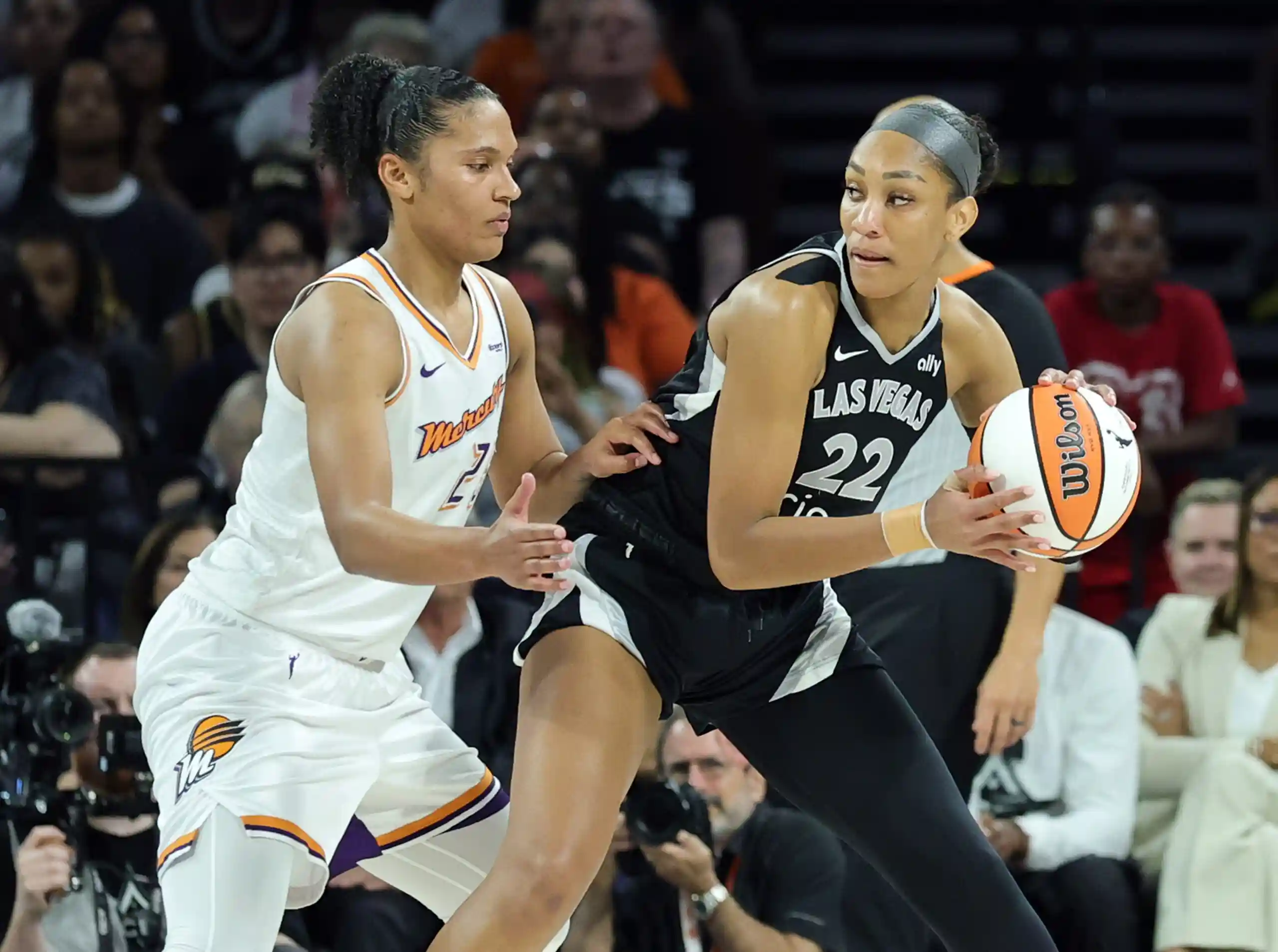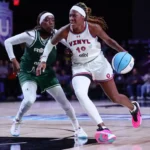What’s sure to be a thrilling WNBA Finals is somewhat marred by the coming storm forecasted in the lead-up.
Shooting lights out could take on a new, and rather dire, meaning as this WNBA season comes to an end.

In any other year, the 2025 WNBA Finals, staged between the Las Vegas Aces and their unexpected guests, the Phoenix Mercury, would be a thrilling, high-octane conclusion to a thrill ride of a tour. It still can be that epic end, especially with a best-of-seven format in play for the first time, but the hardly-buried subplot is that it’s a mere calm before the storm, nay, the downright hypercane, that will be labor negotiations between the WNBA and its players.
For all intents and purposes, these Finals, like their very recent predecessors, should be a culmination of the ongoing progress in women’s basketball that places it on a healthy path forward. No matter how long the best-of-seven series lasts, the games played will be the last before the collective bargaining agreement expires on Oct. 31—a macabrely ironic deadline that hints at the spooky road ahead.
Parity, for example, is certainly alive, as seven of the league’s 13 teams have appeared in a WNBA Finals series in the new decade. That percentage will only decrease because two more teams will enter the ranks in 2026, with an additional trio to follow in the ensuing years. Ratings remained stable, and in some cases rose, despite the long-term absence of league face Caitlin Clark, which is no doubt music to the ears of those who just dished out ten figures to have games on their airwaves.
It’s perhaps too good to be true for a league that has fought to not be a punchline, that has sought perhaps the bare minimum in the form of an even opportunity and playing field for the greatest female athletes. As this week proved, however … it probably was.
A Laborious Labor Battle Looms
One can effectively argue that the WNBA postseason action on the court—featuring the downfalls of the respective defending champion and top seed at the hands of the aforementioned Mercury, and the Indiana Fever team that Clark left behind was an overtime away from joining them if not for A’ja Wilson once again fulfilling the middle initial in MVP—pales in comparison to what has transpired away from it.
This offseason’s early transaction log has already bid farewell to three head coaches, and countless fines have been assessed to those who have survived the purges continue to line the league’s pockets. But Minnesota Lynx franchise face Napheesa Collier, a victim of a controversial lack of call and one of Phoenix’s victims, went out in style and a deafening bang that would make Mike Breen blush.
“We have the best players in the world. We have the best fans in the world, but right now we have the worst leadership in the world,” Collier called in her exit interview, per Myron Metcalf of ESPN. “We serve a league that has shown they think championship coaches and Hall of Fame players are dispensable, and that’s fine. It’s professional sports, but I will not stand quietly by and allow different standards to be applied at the league level.”
Further scorching the league’s earth, Collier revealed details of private conversations she had with WNBA commissioner Cathy Engelbert, which hint at brushing away the pressing league issues beyond the burning question of revenue sharing that rightfully dominates the CBA talks.
“This past February, I sat across from (Engelbert) and asked how she planned to address the officiating issues in our league,” Collier recalled, per the Associated Press. “Her response was, ‘Well, only the losers complain about the refs.’ I also asked how she planned to fix the fact that players like (Clark, Paige Bueckers, and Angel Reese), who are clearly driving massive revenue for the league and are making so little for their first four years.”
“Her response was, ‘(Clark) should be grateful. She makes $16 million off the court because without the platform that the WNBA gives her, she wouldn’t make anything.’ In that same conversation, she told me, ‘Players should be on their knees, thanking their lucky stars for the media rights deal that I got them.'”
Shocking as such accusations against Engelbert are—ones that no one in the league office has denied or commented on beyond a statement of respect for Collier from the commissioner herself—so much could have, and maybe still could, gone wrong by revealing them. If the league wasn’t negotiating in good faith prior to Collier’s reveal, revealing the details of private conversations would surely create no pleasantries.
One could even argue if Collier was the best messenger: the UConn alumna has never been one to hide her opinions, but if anyone stands to benefit from a WNBA work stoppage, it’s Collier and the 47 others (and possibly more) set to partake in the Unrivaled three-on-three league she formed alongside Breanna Stewart.
But perhaps the one thing that could’ve worked in the league’s favor—player dissent and disagreement, somewhat prevalent in the wake of rising debates such as that over the new guard led by Clark—has fallen in favor of a united front that has doubled, perhaps even tripled, in solidarity since last season.
“I just think they’re failing us as a league, definitely failing us as players,” Fever depth star Sophie Cunningham said in her own closing statements (h/t Indiana Fever on YouTube) “Everything that Napheesa said, we all feel that way, and we’re all going to back her, and I think that’s pretty strong coming from her. I think a lot of us have been saying that, but when it comes from someone of that caliber of a player, that we’re being serious.”
“I’m grateful to have those type of people to be able to continue to speak up for us,” added Wilson, per Alexa Philippou of ESPN. “I’m going to ride with Phee always. Obviously, she’s a business girlie and she has her own stuff going on, but moving forward, we’ve got to continue to stand on business as we talk about this CBA negotiation.”
The WNBA Faces an Uncomfortable Truth
As Jeff Goldblum’s Ian Malcom futilely warned his hosts in the original “Jurassic Park” … perhaps the league’s “scientists” were so preoccupied with whether they could, they didn’t stop to think if they should.
Even if no one will buy a ticket to see them work, Engelbert and Co. have no doubt grown the league and left it in a better place than they found it. Engelbert long ran on de facto promises of expansion and progress toward major league legitimacy. It took longer than anticipated, due to factors both within and beyond her control, but it’s finally starting to come to fruition.
By extending the entertainment, the opportunities, and the chance to keep rising, the league asked more of its players, who rightfully want to be better compensated for their work, all while acquiescing to these demands.
Side effects, evidence that each side perhaps hastened into a larger deal and more evidence as to why the players backed out of the current CBA early, have made themselves all-too-known: the expanded 44-game schedule might have whetted the appetites of television partners but led to increased injuries and a jam-packed schedule that forced more back-to-backs and rendered the All-Star break a rest in name only for the light’s most prominent stars.
All of that and more has placed the league in an uncomfortable spot, one where it has far more to lose than the players on the other end of the table do. It’s now in a position where its new features, be it new club, new television appearances, new games to play, are coming back to work against it and raises a question over whether the league bit off more that it can chew.
That’s all the more reason to enjoy these Finals for what they are: the war could be the last bit of peace the WNBA carries for some time.
Geoff Magliocchetti is on X @GeoffJMags
